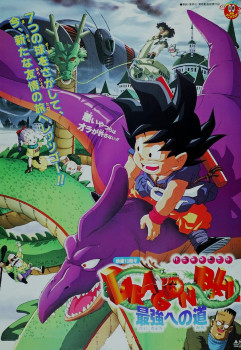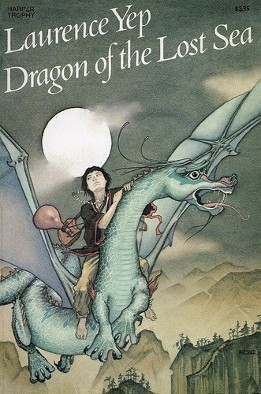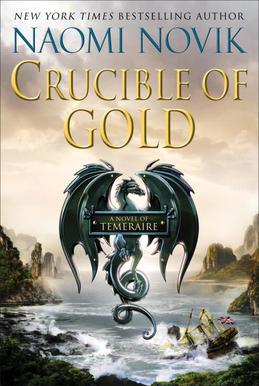Laurence Michael Yep is an American writer. He is known for his children's books, having won the Newbery Honor twice for his Golden Mountain series. In 2005, he received the biennial Laura Ingalls Wilder Medal for his career contribution to American children's literature.

The Surprising Adventures of the Magical Monarch of Mo and His People is the first full-length children's fantasy novel by L. Frank Baum. Originally published in 1899 as A New Wonderland, Being the First Account Ever Printed of the Beautiful Valley, and the Wonderful Adventures of Its Inhabitants, the book was reissued in 1903 with a new title in order to capitalize upon the alliterative title of Baum's successful The Wonderful Wizard of Oz. The book is only slightly altered—Mo is called Phunniland or Phunnyland, but aside from the last paragraph of the first chapter, they are essentially the same book. It is illustrated by Frank Ver Beck.

Dragon Ball: The Path to Power, is a 1996 Japanese animated fantasy martial arts adventure film and the seventeenth animated feature film based on Akira Toriyama's Dragon Ball manga, following the first three Dragon Ball films and thirteen Dragon Ball Z films, and the final film in the series to use cel animation. It is a reiterating of the original Dragon Ball anime series, this film is a reboot, borrowing the elements from the first Dragon Ball search and the later Red Ribbon storyline. It was first released in Japan on March 2 at the Toei Anime Fair, along with the film version of Neighborhood Story. The film was produced to commemorate the tenth anniversary of the original Dragon Ball anime. It was also the last theatrically released Dragon Ball film produced up until the release of Dragon Ball Z: Battle of Gods in 2013.
Yasmine Galenorn is an American novelist. She writes urban fantasy, paranormal romance, and paranormal mystery. She previously wrote under the pen name India Ink for her Bath and Body series.

Empire of Ivory is the fourth novel in the Temeraire alternate history/fantasy series by American author Naomi Novik. Set in Africa, the novel follows William Laurence and his dragon Temeraire's search for a cure to the disease that has paralyzed the dragon community. Novik visited southern Africa in search of places in the fourth novel.

The wildlife of the Gambia is dictated by several habitat zones over the Gambia's land area of about 10,000 km2. It is bound in the south by the savanna and on the north by the Sudanian woodlands. The habitats host abundant indigenous plants and animals, in addition to migrant species and newly planted species. They vary widely and consist of the marine system, coastal zone, estuary with mangrove vegetation coupled with Banto Faros, river banks with brackish and fresh water zones, swamps covered with forests and many wetlands.

Shadow Star is the third book in the Chronicles of the Shadow War trilogy.

Dragon of the Lost Sea is a fantasy novel by American author Laurence Yep. It was first published in 1982 and is the first book in his Dragon series. Having already written several books, Yep had wanted to adapt Chinese mythology into a fantasy form for some time, and began writing the story in 1980 after undertaking careful research. He had originally intended to adapt a Chinese folktale in which the Monkey King captured a river spirit who had flooded an entire city, which he at first tried to conceive in picture book form.

Dragon Cauldron is a fantasy novel by American author Laurence Yep first published in 1991. It is the third book in his Dragon tetralogy. Dragon Cauldron marks a shift in narration from Shimmer, who had narrated the first two books in the series, to Monkey, who had up to that point played a minor role. Yep found it necessary to change narrative voices after six years of trying to write Dragon Cauldron. Monkey's status as an immortal made him "naturally cheerful even in the most dire of situations. Tough and yet funny, his consciousness provided the right platform from which I could observe a world in crisis". He had to modify the outline he had been working with as he decided that it would be necessary to kill off at least one character in order to provide "jeopardy" to Shimmer and her companions, which in turn would convey drama and emotional truth. This also allowed him to incorporate new material based on Chinese folklore that he had researched, forming the basis for the characters the Smith, the Snail Woman, and the Nameless One.

Dragon War is a fantasy novel American author Laurence Yep first published in 1992. It is the fourth and final book in his Dragon series. Yep attempted to put the beauty and gallantry of dragons he had gleaned from his research of them in Chinese mythology into Dragon War. By contrast, in the first three books of the series he "had tried to capture their quirkiness and strength".
The Dragon series is a tetralogy of fantasy novels by American author Laurence Yep. Yep had already written several books including the Newbery Honor novel Dragonwings by 1980, when, after undertaking careful research, he decided to adapt Chinese mythology into a fantasy form, something he had always wanted to do since he had sold his first science fiction story at 18. He "tried to stay true to the spirit" of these myths, but did not try "to keep their exact details". The "perfect vehicle" he chose was a folktale in which the Monkey King captured a river spirit who had flooded an entire city, which he at first tried to conceive in picture book form. However, he kept questioning the motivations of the river spirit, whom he had renamed Civet. This resulted in the realization, as his outline ballooned exponentially from eight to 800 pages, that he would need a series as opposed to just one book to tell her story.

Crucible of Gold is the seventh novel in the Temeraire alternate history/fantasy series by American author Naomi Novik. This installment features the adventures of William Laurence and his dragon, Temeraire, in South America.

Shimmer and Shine is an American animated television series created by Farnaz Esnaashari-Charmatz and produced by Nickelodeon Animation Studio. It premiered on Nickelodeon's Nick Jr. block on August 24, 2015, and ran for four seasons. The show is about two genies, Shimmer and Shine, who grant wishes for their human friend Leah.

James Bond 007: Serpent's Tooth is a 1992 spy comic book limited series, packaged by Acme Comics and published by Dark Horse Comics, featuring Ian Fleming's secret agent, James Bond in the lead. Consisting of three issues, it is written by Doug Moench and illustrated by Paul Gulacy. It is also the first comic book in a series of Bond adventures in the run of the publisher.

The Tiger's Apprentice is an action-adventure fantasy novel by American author Laurence Yep. It was published in 2003 as the first in The Tiger's Apprentice trilogy. This story inserts ancient Chinese mythology into modern life in San Francisco. The story follows the boy Tom as he becomes the magical apprentice of the tiger Mr. Hu. Together with a band of mythological misfits, their job is to protect the ancient phoenix from Vatten and the Clan of Nine who wish to use its powers for evil. The story explores themes of kindness, loyalty, duty, and bravery.
Rayla is a fictional character from the Netflix animated fantasy television series The Dragon Prince. She is introduced as a prodigy Moonshadow Elf assassin and the protégé of veteran assassin Runaan. Sent on a mission to avenge the death of the king of the dragons, she ultimately joins forces with the human princes Callum and Ezran in order to deliver the egg of the Dragon Prince back to his mother. Over the course of the series, Rayla and Callum develop a romantic relationship. She is voiced by Paula Burrows.
The Ruby Prince is a South Asian folktale, first published in the late 19th century by author Flora Annie Steel. The tale is a local form of the cycle of the Animal as Bridegroom or The Search for the Lost Husband, in that a woman marries a man of supernatural origin, loses him and must regain him.
The King of the Snakes is a Chinese folktale published by John Macgowan in 1910. In it, a father gives his youngest daughter to a snake spirit, who turns out to be a human. Out of jealousy, the girl's sister conspires to take her place and kills her. The heroine, then, goes through a cycle of transformations, regains human form and takes revenge on her sister.
Yasmin and the Serpent Prince is a Persian folktale published in 1974 by author Forough Hekmat. It is related to the international cycle of the Animal as Bridegroom or The Search for the Lost Husband, in that a human princess marries a supernatural husband or man in animal form, loses him and has to seek him out.












